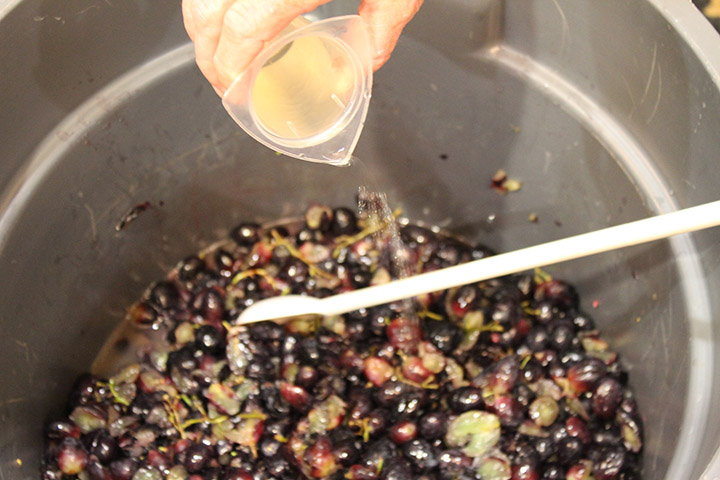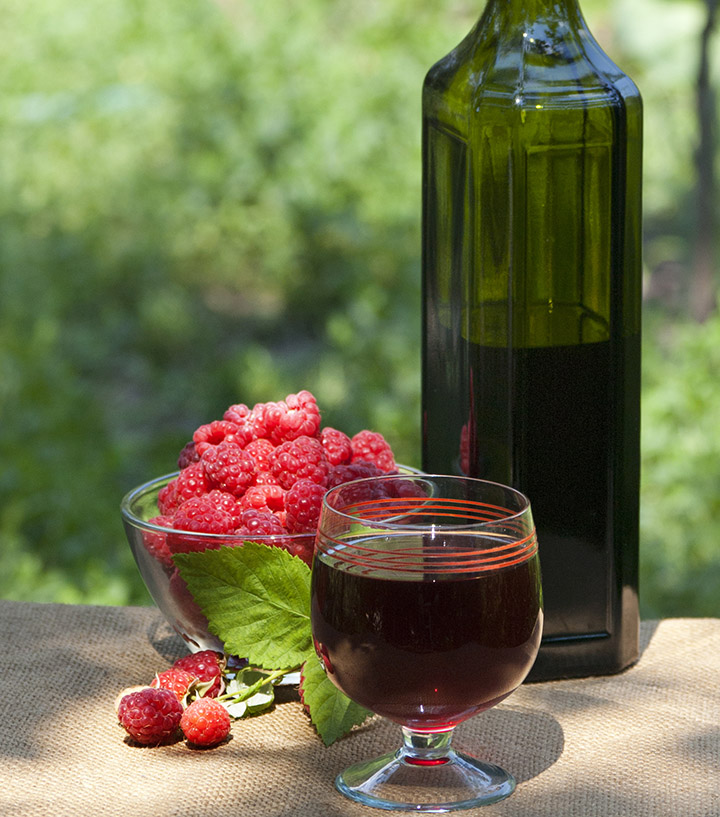When you make grape jelly at home, your recipe may call for adding pectin. Commercial pectin is sold as either a liquid formula or a granular white solid. When you make wine at home, your recipe may call for adding pectic enzyme, also commonly either a liquid preparation or a white granular solid. You may be asking yourself how they relate and what is going on here?

Ultimately, we are getting at the structural materials of plant tissues. Cellulose is a class of plant polysaccharides — sugar polymers — that provide a rigid structure to cell walls in plant stems, fruit skins, wood, and other plant parts. Cellulose is not just one chemical compound, but rather the term describes a class of related linear polymers based on the glucose sugar molecule. Hemicellulose also describes a class of compounds rather than one specific molecule. These also provide structure to plant cell walls but are more branched and are typically smaller chains than cellulose. In addition, hemicellulose polymers include a variety of sugar building blocks, not just glucose. These polymers contribute to plant structure by cross linking and reinforcing the cellulose structures. Pectin is yet another class of plant structural polysaccharides. It is often considered the “glue” that helps bind cellulose and hemicellulose together to make durable cell walls. A plant-based fiber like cotton may be as much as 90% cellulose, but fruits, including wine grapes, have a more diverse blend of structural polysaccharides. Before grapes ripen, the structures in the immature green berries are quite rigid, protecting the fruit from damage and depredation by animals. As grapes mature, the pectic content begins to break down, allowing the fruit to soften and become palatable. The softening mechanism depends on today’s topic: Pectic enzymes. These naturally occurring proteins are expressed during ripening, breaking specific pectin bonds, destroying the polymer chains, and causing cell walls to soften.
Pectin can form a stable gel at low pH and high sugar content. If these conditions are met naturally, you may not need to add pectin to your jelly-making project. If not, you may need to add acid (often lemon juice), sugar, and commercially prepared and purified pectin. Pectin is more soluble in water than it is in ethanol, so if you have an excess of pectin in your home winegrape juice, fermentation into wine may cause it to become less soluble. There is not enough to turn your wine to grape jelly, but it can certainly leave your wine cloudy. Earlier in the process, your crushing and pressing of the grapes may not have been as thorough as you would like in releasing juice, anthocyanin pigments, and aroma compounds. Just as you can add pectin to a jelly recipe to make a stiffer gel, you can add pectic enzymes to supplement the natural content to do the opposite in juice or wine.
Biological life processes depend on the actions of enzymes. When the outcome of a biochemical reaction is energetically favored but blocked by other factors, enzymes provide the “work around.” They participate as catalysts in breaking target molecular bonds, but do not get used up themselves. Enzyme molecules can go on and react again and again as they encounter the specific target substrates. Just as seen in the discussion of pectin and pectinase earlier, enzymes are commonly named with an “-ase” ending added to the substrate name. One winemaking enzyme that does not follow the typical naming pattern is lysozyme, derived from egg whites and used to inhibit or stop malolactic fermentation (MLF). Other than that specific product, most winemaking enzymes are considered macerating enzymes — they facilitate grape and grape skin maceration and breakdown. None of the products I have run across are produced by genetically modified organisms (GMOs) and all would be considered vegetarian. They are produced using selected strains of vat-grown Aspergillus niger fungus.
American and French-American hybrid grape varieties are often more prone to excess pectin than vinifera varieties and may need regular additions of macerating enzymes. Other important functions of macerating enzymes are often addressed in conjunction with pectinases. These are referred to as “side activities” and extend beyond the degradation of pectin. For softening grapes prior to pressing, cellulose and hemicellulose can be degraded by corresponding cellulases and hemicellulases. Breaking down grape cell wall structures can help release anthocyanin color compounds and tannins to produce more intense and more stable red wine color. While natural yeast enzymes during fermentation also contribute to these maceration reactions, they are often supplemented with commercial enzyme products. Aroma compounds in grapes may initially be bound to a sugar molecule, leaving the aromas undetectable. By breaking the sugar bonds with added enzymes, called glycosidic enzymes or glycosidases, the aromas can be released. Enzyme activities are inhibited in their actions by alcohol and by sulfites and they are precipitated by bentonite fining. Suppliers include advice about using specific products on crushed fruit, juice, or wine after alcohol is present. If applying an enzyme to sulfited must, wait at least 15–20 minutes after adding sulfite before adding the enzyme product. Do not fine with bentonite until desired enzymatic action is complete.
Products called simply “pectinase” are widely available from home winemaking suppliers. In powder form, you may find it for sale for less than $5 for a 1-ounce (28-g) package that will treat about 200 lbs. (90 kg) of crushed fruit. Also available are active liquid formulations for similar maceration of fruit. The pectinase breakdown and removal of pectin improves press yield for white wines, rosés, and apple or pear ciders. It also helps head off a pectin haze that might occur later when the presence of alcohol may cause pectin to precipitate. These products, also called pectic enzyme or pectolytic enzyme, are generally produced to be used on crushed fruit or fresh juice prior to fermentation. Use instructions may also advise avoiding addition too close to a sulfite addition. Since bentonite fining removes proteins, you must also avoid adding bentonite prior to adding pectinase or you will remove your own enzyme addition. Allow the pectinase to do its work before moving on with fining.

For pectic enzyme products with additional functions or side activities, a much wider range of products from many producers can be found. While some of these “pectinase plus” products are not packaged in small enough quantities for home use, the dry granular versions, kept sealed and cool, should be usable for up to two years. Liquid preparations have a shorter shelf life.
Scott Laboratories has long provided a range of enological enzymes under the Scottzyme brand and distributes those of several other producers as well. Looking at the primary applications of pectic enzymes — improving juice yield and addressing wine clarity — Scottzyme Pec5L, HC, KS, and Spectrum all include advice related to these objectives. Let’s take a closer look at these, as well as products from Lallemand and Enartis:
• Pec5L is a liquid preparation with applications and instructions resembling those of generic pectinase. It is to be diluted and then can be added to crushed grapes before pressing for white or rosé wines or to crushed apples or pears for cider with the goal of improving juice yield. Added to juice or wine, it can improve clarity and make filtration more efficient.
• Scottzyme HC, also a liquid preparation, comes with similar recommendations but goes a bit further. Described by Scott Labs as including pectinase with cellulase side activities, it is recommended for improving press handling of slippery grapes like Concord, Muscadine, Norton, and hybrid varieties. It can be used in grape must, juice, or wine to improve clarity and filterability.
• Among the clarifying products, Scottzyme KS goes further still. It is intended to improve clarity and filterability but is not recommended for juice yield. It has what Scott Labs describes as very aggressive enzymatic activity and should not be added before pressing as it will break down skins and produce many small particles. In this product, the pectinase is accompanied with side activities including cellulase, hemicellulase, and protease. It can be used in juice or wine.
• Scottzyme Spectrum takes clarification and filterability beyond the juice or fruit stage and does not address juice clarity or yield at the press. It is recommended only for use on finished wine post-fermentation. It has the same cautions regarding use on fruit as KS but cautions against use on juice as over-clarification may result, causing fermentation difficulties. Like KS, its pectinase formula has cellulase, hemicellulase, and protease activities.
• Lallzyme EX, produced by Lallemand, is recommended to improve juice yield and moves into areas of stabilizing color and improving mouthfeel. Recommended for use in grape must, its pectinase activities are accompanied by cellulase and hemicellulase side activities. The enzymes liberate tannin-bound polysaccharides, improving mouthfeel and stabilizing colors in light-bodied and medium-bodied reds. It is a granular material that is dissolved in water and added to crushed must at the start of fermentation or during cold soak.
• Another major manufacturer, Enartis, includes EnartisZym Color among its enzyme products. This pectolytic enzyme preparation increases extraction of phenolic compounds, notably tannins and anthocyanins. It is rich in cellulase and hemicellulase activities, yielding more intense and more stable color. In particular, it is recommended for faster and better phenolic extraction from underripe or moldy grapes.
• On the white side of production, Lallzyme Cuvée Blanc is also a skin-contact macerating enzyme preparation. Added to white grapes (or red grapes intended for rosé), it can improve juice yield and clarification, as with straight pectinase. It goes further and helps release bound aroma compounds in the grape skins through side activities of ß-glycosidase. It is recommended for use on crushed grapes, but not for juice or wine.
• EnartisZym Arom MP is also a pectinase preparation that is intended to release bound aroma compounds. Pectolytic enzyme activity improves juice yield and clarification, with side activities of cellulase, hemicellulase, and protease. Besides helping to release aroma molecules, the protease activity can also help with protein stability and allow reduced bentonite use by destroying proteins that might otherwise cause a haze. It is recommended in maceration of white grapes.
Other wine product suppliers including Laffort, ATPGroup, and home winemaking shops, also produce and distribute macerating enzymes for enological use.
While pectic enzymes primarily break down pectin to release juice, that is not the end of the story by any means. Better maceration, improved press yields, and handling of slippery musts move into the side activities of some of these products. If you are also looking for aroma release, improved mouthfeel, or color stability, you may want to ask your fermentation product supplier about pectinase products — and their side activities.





